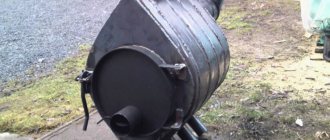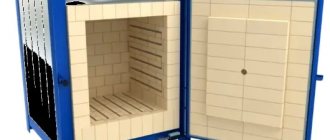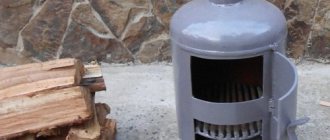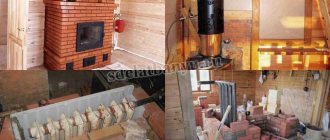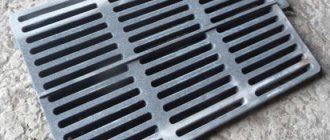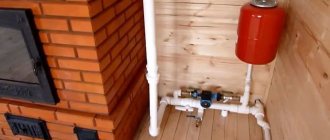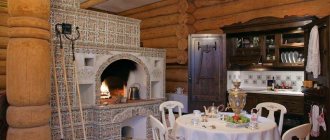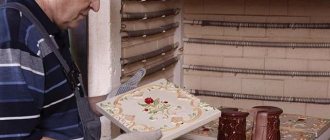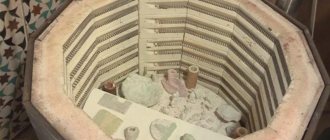To make clay crafts durable and strong, they must be subjected to heat treatment. You should not burn clay in a conventional oven or gas-powered stove - this is not only ineffective, but sometimes even dangerous (toxic substances can be released during processing). For such a procedure, you will need a special sealed oven that can be heated to the required temperature. Such a device can be bought in a store, but if you wish, and if you have good instructions, you can make a clay kiln with your own hands.
- 1 Technology for making a pottery kiln
- 2 Method one. Making a chamber stove from a refrigerator or washing machine
- 3 Method two. Making a stove without having a metal casing at hand 3.1 Video - wood burning stove
Classification of pottery kilns
Furnaces for firing clay and ceramics are primarily divided according to temperature conditions. The most powerful of them operate in the range from 1400 to 2000 degrees. The second category includes models whose operating temperature is 900-1400 degrees. Equipment operating in medium temperature conditions provides heating from 400 to 900 degrees. Low-temperature models can heat up no higher than 500 degrees. Of course, a stove with the ability to adjust the temperature will be most functional.
Depending on the fuel used, pottery hearths can be wood, gas or electric. Modern industry produces appliances powered by gas and electricity; wood-burning options can rarely be found and are only home-made. The combustion temperature of wood does not allow obtaining powerful high-temperature equipment.
Gas pottery kiln Electric clay kiln
The power of furnace equipment is one of the main selection criteria. For a small fireplace with a volume of up to 50 liters, 100 W per liter is required. If the chamber has a size of 100 to 500 liters, a power of 50-70 W per liter is sufficient.
The shape of firing furnaces can be bell-type, tubular with vertical loading or chamber with horizontal loading. Round kilns distribute heat evenly, while bell-type and chamber kilns are more convenient for serial firing and working with large products. Beginners are advised to pay attention to models with a viewing window that allows visual control of the process.
New-generation refractory raw materials, which are light in weight and have low thermal conductivity, are used as materials for the manufacture of pottery equipment. Heavy and massive equipment made of fireclay is practically never produced.
Thermocouple
The thermocouple has been used for measuring the temperature in a furnace for quite some time. At the same time, it has established itself as a reliable measuring device. Essentially, these are two wires consisting of different alloys, which are connected to each other by welding.
When measuring temperature, a current is generated at the ends of the wires, and the higher the oven temperature, the more millivolts we get at the output. Using special devices, you can easily convert millivolts into a temperature indicator.
There are a huge number of types of thermocouples, which consist of different alloys. A type K thermocouple is intended for the muffle furnace. It consists of a chromel-alumel alloy and is designed for temperatures up to 1300 °C. For high temperature environments, it is recommended to use a thick wire thermocouple.
You can measure the temperature inside the furnace with a thermocouple using various devices. We will describe some of them below.
A multimeter is an affordable measuring device; in its design, the function of determining temperature with a K-type thermocouple is immediately thought out. Basically, this type of converter is immediately sold in a set with a multimeter. The only drawback is that the TCA proposed in this version is thin and quickly breaks down at high temperatures.
You can also use type S thermocouples based on platinum-rhodium-platinum alloys. They are more expensive than K-type thermocouple alloys, but withstand high temperatures better as they are rated for 1600 °C and will last longer. According to the standard, such a thermocouple is supplied already in a protective casing.
The thermal converter TPP, like the thermocouple K, is connected to an electronic converting device. Thus, it is possible to easily determine the temperature in the oven and regulate it using a user program.
The TXA converter is another type of meter connected to the controller
It is important here that the length of the wires is sufficient. If the wiring is initially short, then you can use special temperature compensation wires
It is important to understand that the material of the extension wire must consist of the same alloys as the material of the converter itself. But its diameter should be smaller.
By connecting a thermocouple to the controller and connecting them to power, you can immediately find out the temperature in the muffle furnace. To make firing even easier, use the controls and automatically control this process.
On the Tekhnonagrev website you can choose the most suitable thermocouple option and extension wires. If necessary, contact our managers for advice.
When working with a muffle furnace, do not forget about protective equipment. Even when a stove is more than adequately insulated, its outer surface can become hot enough to seriously burn someone if touched with unprotected skin. Therefore, use the following personal protective equipment:
Kiln mitts or gloves: These should be worn when handling any part of the kiln (other than the control panel) while it is firing or cooling. Even after turning off the power, the oven will remain hot for several hours. Do not open or touch it until completely cooled.
Sunglasses. It is recommended to use special safety glasses to observe openings in the oven. They protect your eyes from radiant heat. Regular sunglasses are not suitable for this purpose and can even cause harm, because... not designed for high temperatures. Safety glasses may also allow you to see your cones, if you are using them, more clearly.
Design features of an electric furnace
The design of the electric furnace consists of a heating chamber and thermal insulation that ensures temperature preservation. The ideal heat accumulator is fire-resistant brick, which 21st century craftsmen additionally insulate with modern materials, significantly reducing the thickness of the walls and simplifying construction.
Depending on the type of arrangement of the heating element, electric furnaces can be muffle and chamber. The structure of a muffle furnace implies the placement of a heating element around a container made of refractory material - it is more difficult to make such a structure yourself, and its heat loss is higher than in a chamber furnace.
Muffle furnace design
How to choose the right camera size
Which oven to choose based on the size of the chamber. Someone immediately thought, the more, the better and immediately passed it by. In fact, it's better to speculate a little. Estimate how much work is approximately being done and how much will be offended at one time. If you buy one that is too small, the firing time will make any ceramist nervous. The work will be idle and deteriorate. This will also happen if the size selected is too large. The energy consumption will be enormous, but only a small part will be fired. The master will begin to put several works aside, which will wait their turn, when at this time I could already paint the finished works and cover some with glaze.
Electric brick kiln for firing clay products
This homemade clay kiln has a working volume of 13 liters. The open spiral allows you to heat the chamber to 1000 degrees in an hour and a half. In this case, the temperature of the external walls of the equipment does not exceed one hundred degrees.
The stand for the unit is welded from a 20*40 mm profile pipe and coated with enamel.
You can paint the metal base with hammer enamel
A sheet of galvanized steel 1 mm thick is attached to the top, screwing it with self-tapping screws.
Sturdy metal base
For the walls you will need a lightweight refractory brick - this can be ready-made fireclay brick or made in-house. For masonry you need a good fireproof mixture for fireplaces. First, the shape of the fireplace is laid out dry so that, if necessary, the parts can be adjusted and inconsistencies can be eliminated. This can be done on the table to make it more visual and convenient to work. At the same stage, grooves for the heater are prepared.
Dry assembly and groove preparation
The brick bottom is assembled separately, fastening the parts with mortar. Before continuing work, the structure must dry thoroughly. Before laying, the bricks must be soaked so that they do not take moisture from the mortar.
The first row is assembled on the table
A layer of thermal insulation is laid on the metal base; fire-resistant mats made of ceramic fiber are suitable for this purpose. In order to compact the thermal insulation layer as much as possible, it is wetted before attaching the brick bottom.
The base is ready
Next, the stove is placed as usual, but very carefully filling the seams and possible voids.
Laying the walls of the pottery chamber
The lid for the chamber is formed from refractory bricks, fastening the structure with a metal tie.
Brick cover
The heating coil, and here there are three of them, is placed in the prepared grooves. The outside of the unit is insulated with fire-resistant mats, after which it is covered with a galvanized steel casing, cut to the size of the resulting product.
Chamber after firing Finished brick pottery kiln
Building this oven requires not only bricklaying skills, but also electrical knowledge. If your own experience is not enough, it is better to contact a specialist for full or partial help.
Operating rules
The electric oven may only be plugged into a reinforced socket. You can also run a large cross-section wire directly from the shield. In addition, it would be useful to install a circuit breaker.
Since this device model has exposed wires, you need to be extremely careful with it. Do not touch the coils while the oven is running. To avoid accidents, it is recommended to install a limit switch on the door, which will turn off the unit when the door is opened. If you are not very good at electrical work, seek the help of a specialist who can help make the device as safe as possible, including grounding it.
Basic moments
The instructions for the muffle furnace are quite long, it is difficult to describe the entire process, but it is worth highlighting the main points.
The best option is to have an old steel oven casing on hand, as it already has everything it needs to become an acceptable oven casing. All the thermal insulation is there; you just need to get rid of unnecessary plastic elements, if any. Next comes the heating element, which is key.
It will determine the heating temperature, which means the quality of the ceramic products. Such an element will be previously prepared nichrome wire with a thickness of at least 1.5-2 mm. Then follows the process of arranging the thermal insulation of the furnace. To do this, the body must be lined with fireproof fireclay bricks. The entire structure must be additionally covered with basalt wool on top.
The price of a ceramic kiln starts from 40,000 rubles and can reach up to 700,000 rubles.
fb.ru
Good time. This morning was really good. The sun was truly spring. It’s warm.. And the first thing I decided to do was... plant onions. It's really unexpected. Don’t make a stove, but plant onions on the greens. Crazy old man, I myself was surprised at my reckless courage. After all, it’s March 7th. But you shouldn’t blame me indiscriminately. I was led to this decision. First, onions in the underground - which have already sprouted. It would be a shame to throw it away, because no matter how little, 3 bags will rot. Second, to my surprise….. sprouts of young onions appeared in the garden, which had not been harvested since the fall… I planted everything, and began to wonder, scratch the top of the head.. What else could I create?. So I went to get some bread. I walked the dog, I have a noble one - with the name Goddess, if translated from Sanskrit. On the way, I told the electrician everything I thought…..and no, he can’t open his mouth. And if it happens, I’ll close it for him myself and sprinkle some earth on him... He confused the phase with zero... It was a good day! The thermometer showed +20 degrees. Looking at it, my thoughts drew a parallel between degrees and a thermocouple. We need to make a kiln. Project kiln for firing ceramics, day 3 continued under the link..... Using my miracle markings, I marked the barrel for drilling holes for fastening buttons. In the bottom half of the oven, around the entrance (where the burner is) and around the top edge. That is, it turned out, if you look from the side, one line from the edge. Because I think it will be enough. In the Upper half it is also the stove lid, around the outlet, along the edge of the lid, and on the side, in a circle from two edges. Now about cutting out the thermomat. The diameter of the barrel is 60 cm. It’s lucky, because the width of the mat is 60 cm. This means that the circumference of the barrel is 180 cm. I need 3 layers of 60 cm each for the bottom and roof. I cut 180 cm and fold it into a square. You need 2 such squares. But first you need to make the walls. I cut another 360 cm, fold it in half to make a strip 360 x 30 cm and roll it out along the wall. It turns out 4 layers with a slight overlap. Which was cut on both sides and set into each other. Like layers in a Napoleon cake. In total, the total thickness of the layers is 8 cm. The same procedure with the lower part. All this will be sewn with buttons. Now lining the top of the lid or how to fit a square into a circle. Of course you could cut the edges in a circle. But the small, domestic, amphibian pet fiercely grabbed its throat, screaming about the inadmissibility of wasting a valuable resource. I had to bend the edges into the inside of the barrel. It turned out beautiful and weighty. Below is another song. Since I planned to lay an additional layer of fireclay brick there, I had to cut circles out of felt. Cried and cut. Remembering hedgehogs and cacti. Well, the time has finally come to attach the buttons with nichrome wire. And then I realized that I had forgotten where she was. …I searched, searched, searched, searched…. And that’s it….I found a fur-bearing animal…. Now you have to wait until the end of the weekend to buy a spiral for the stove..... Don't tell me until you jump over. Happy holiday dear women..
vk.com
Types by loading type
The general classification according to this criterion divides all units into only two types - frontal and vertical. The more detailed description is as follows:
- horizontal devices are loaded from the front through the chamber;
- There are tubular devices, they are also sometimes called circular, they have a vertical loading method, and they are also designed for firing artistic ceramics, this is facilitated by a more uniform distribution of heat;
- bell-shaped structures are also loaded from above, but at the same time they are designed for larger products.
Another important parameter is the type of filler. Chamber furnaces and muffle furnaces are divided into three types according to this class.
- the first class is general purpose, and the chamber is filled with air;
- the second type is filled with vacuum;
- the third type is a chamber with a gaseous environment inside, and they differ in that heating also occurs in a special atmosphere created by these gases.
Where is the best place to install?
It is better not to place the installation in small and enclosed spaces that do not have ventilation (closets or closets). The stove should not be installed in the room where people live, where they sleep, eat, etc. It is better to choose a separate room for it, with an open window. Where you can create a small studio specifically for firing.
Be sure to maintain a distance from the stove and to any object or wall. It should not be less than 30 cm. And according to fire safety rules, the ceramist should not store near objects or materials that can easily ignite
It is also very important to check the material of the walls that surround the stove. It must not be drywall or other flammable material.
The ideal option is tile or concrete walls.
But the floor should not be ignored; it should also consist of a special material. And it should not be a carpet, parquet, or linoleum sheet. If the floor is not made of concrete or another material that is not on the flammable list, then you should not immediately destroy and break everything. In some cases, it is enough to simply lay a sheet of iron directly on the floor surface and carefully install the stove on it. Date: September 25, 2022
Burners
The burners are taken from those I described earlier. On the right is a small burner, which I have called a 1/2-inch stationary corner burner. On the left is a 3/4 inch corner stationary burner. Their use was not calculated by some scientific method, but was stupidly selected from practice. With a small burner I heat up to 340 degrees, with a large burner I can heat it up to 620 degrees, and with both burners running I can easily heat it up to 730 degrees. I don't need anymore. If you need more, there is nothing stopping you from adding two larger ones.
The burners are placed diagonally. When they operate, hot air swirls in the chamber counterclockwise. This allows for a more uniform temperature distribution throughout the chamber volume. Opposite the burner nozzle, on the opposite corner are triangular bumpers made from scraps of ShL brick. To introduce the flame inside the furnace, it is better to use sleeves, whatever you can find. On my right is a sleeve made from a piece of mullite-silica MKR tube. On the left is from a piece of stainless pipe.
Gas supply can be solved in any way. In the photo, using a half-inch pipe and the same ball valves (view from the bottom of the muffle body). The structure is attached to the furnace body and to the panel. The handles are brought out through the panel. Don’t forget to draw where to close, otherwise you will turn in the wrong direction in the heat of the moment
